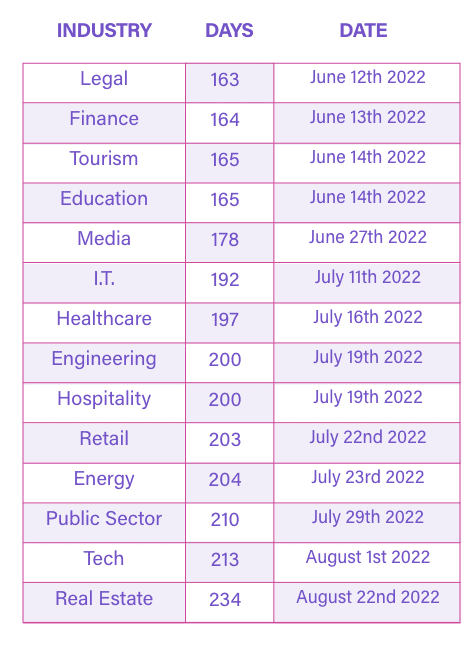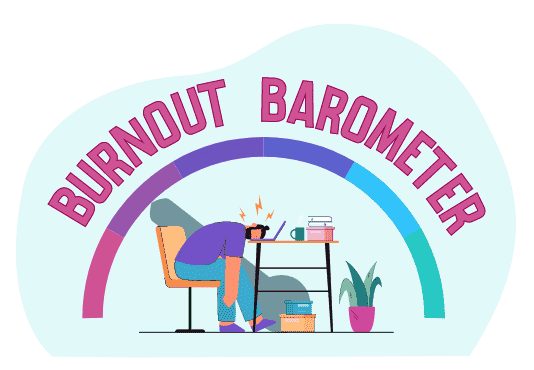PORTLAND, Ore. – Thanks to technology that has made us reachable whenever, wherever, many peoples’ jobs have morphed into round-the-clock activities and remote working has made it even more difficult to unplug. Phones are set to mirror work-related email and calendar notifications (even after hours). But this continual hustle can result in chronic workplace stress, leading to debilitating fatigue; negative feelings towards work; and reduced efficacy. These are defining characteristics of burnout, which often goes hand in hand with both anxiety and depression, and it’s even been suggested that burnout may be a form of work-related depression. While burnout and stress may feel the same in the moment, burnout is chronic stress that hasn’t been managed effectively.
MyBioSource.com, a biotechnical products distribution company, conducted a survey of 4,031 workers across the country to determine a burnout benchmark of the exact date they experience work burnout. The average employee in America experiences burnout as early as 191 days in the year, which took place on July 10. Employees in the Legal industry experience the earliest on-set burnout, just 163 days into the year: June 12. This is perhaps expected, given the long hours and stressful circumstances often involved in legal work. Comparatively, those in the Real Estate industry seem to experience it latest in comparison to others, 234 days into the year on August 22. This could be due to home sales picking up more over Spring and Summer.
Broken down across states, the average employee living in Vermont experienced burnout before those in other states: just 127 days into the year on May 7. By comparison, employees in Tennessee experienced their peak burnout 180 days into the year, on June 29.
Industries in which workers experience the earliest burnout in the year:
1. Legal: burnout by June 12.
2. Finance: burnout by June 13.
3. Tourism: burnout by June 14.
4. Education: burnout by June 14.
5. Media: burnout by June 27.
Industries in which workers experience the latest burnout in the year by comparison:
10. Retail: burnout by July 22.
11. Energy: burnout by July 23.
12. Public sector: burnout by July 29.
13. Tech: burnout by August 1.
14. Real Estate: burnout by August 22.

Burnout Recovery Strategies
The APA’s 2021 Work and Well-Being study discovered that more than three-quarters of employees had experienced stress related to work matters in the month prior to the survey, and almost 3 in 5 employees reported experiencing negative impacts of work-related stress. Meanwhile, 32% reported emotional exhaustion, while 36% reported cognitive weariness and an overwhelming 44% said they had experienced physical fatigue.
Here are 5 tips to help with recovering from burnout:
1. Try taking short breaks throughout the workday
Even though they’re quick, five- or ten-minute micro-breaks between tasks during the day can help reset your energy levels, especially if you’ve been sitting down for a prolonged period. During these quick refuel breaks, you could practice mindful breathing exercises; take a short walk up and down the stairs; meditate or simply doing some stretching.
2. Set balanced work-life boundaries (and stick to them)
Especially if you work remotely, these boundaries are essential to help ensure your work life doesn’t intrude on your personal life. Stick to a day schedule and make sure to delineate strict hours for the start and end of the workday.
3. Open discussions about burnout in the workplace
It can feel isolating when you’re experiencing negative symptoms onset by burnout, therefore, creating space for informative discussions about this occupational phenomenon can be helpful in sharing advice, as well as prevention and management strategies.
4. Make sure you’re getting enough rest
Many employees think they can push through the debilitating symptoms of burnout, but the truth is that adequate rest is often the best remedy. Try slowing down your daily pace and pay attention to what your body and mind need.
5. Get professional support
If you’ve tried a variety of measures and methods to alleviate burnout symptoms to no avail, it could be worthwhile to look into support programs or counseling to receive professional help. When mental health is on the line, it’s important to help manage the issue at hand effectively and sustainably.









